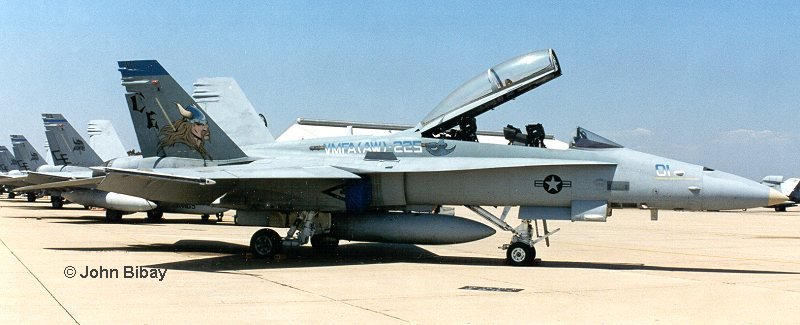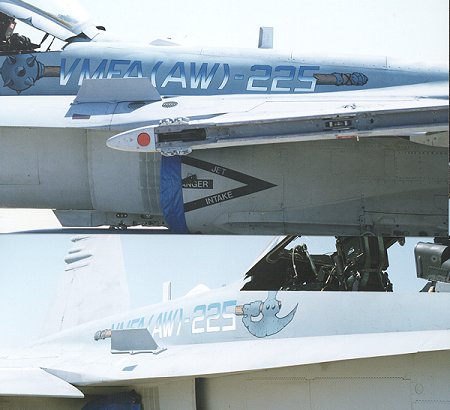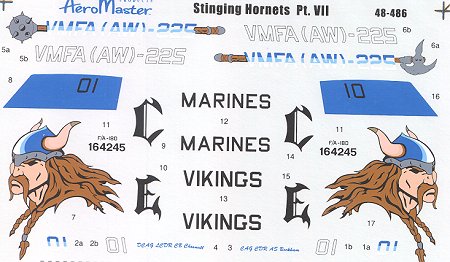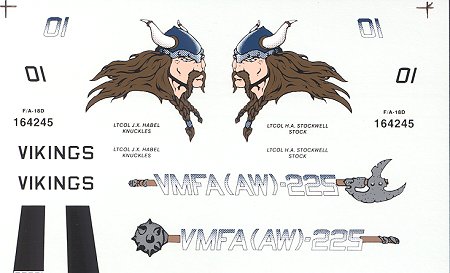
VMFA-225
F/A-18D Decal Sheet Comparisons
by
John Bibay

Mention Navy and Marine Corps F/A-18 Hornets, and the words "colorful" and "distinctive" donít always come to mind. For me, one Hornet that does immediately spring to mind is COís jet of The Vikings, Marine All-Weather Fighter Attack Squadron Two Two Five (VMFA(AW)-225). There have been two different F/A-18Dís painted in full-color markings. The earlier one was BuNo 164245 and then was painted up by (then) Sgt. Boone. This scheme lasted until spring 1998 when the Vikings returned from a six-month deployment to MCAS Iwakuni. The Vikings traded in their jets for brand-new F/A-18Dís. Once again, SSgt Boone painted up the COís jet, this time BuNo 165410. This particular jet is the one so faithfully depicted by the Orion Modelís decal sheets.
The two jets are different in markings and in physical changes on the airframe itself. Dave Roof has done an exhaustive job pointing the modifications for the later jet, so I wonít repeat them. For those of you who want to reproduce the earlier jet in 1/48th scale, Superscale, Aeromaster, and CAM decals have produced sheets for BuNo 164245 in this scale. The purpose of this article is to point out the pluses and minuses of each sheet and point out corrections that are required for the Hasegawa F/A-18D kit.

 Before discussing the different
sheets, it would be wise to point out generalities of the older jet. The tails
has a Viking head with flowing hair that is light brown/ blondish in color. The
helmet is blue with a white highlight, gray, light brown and off-white horns.
Both eyes are red. The hair is not the same on both sides, but the differences
are negligible in 1/48th scale. The "01" and "CE"
on the tail is black with a thin white outline. You probably wonít miss the
white outline in 1/48th.
Before discussing the different
sheets, it would be wise to point out generalities of the older jet. The tails
has a Viking head with flowing hair that is light brown/ blondish in color. The
helmet is blue with a white highlight, gray, light brown and off-white horns.
Both eyes are red. The hair is not the same on both sides, but the differences
are negligible in 1/48th scale. The "01" and "CE"
on the tail is black with a thin white outline. You probably wonít miss the
white outline in 1/48th.
The port side of the fuselage has mace and the starboard side a battle-axe. Superimposed on both weapons is "VMFA(AW)-225" in a graded blue to white and slanted to the rear. The "01" nose each side of the nose is also a graded blue to white and slanted to the rear. The "MARINES", national insignia, jet intake chevrons and BuNo are black. Early in its life, the crew name below the canopy rail was in script, later it was in block letters. Both styles of crew name were only on the port side. Iíve never personally seen walkways nor any photos of black walkways on this jet. This jet had very few, if any stencils on the wings and fuselage. "VIKINGS" was painted on the centerline fuel tank in block letters. I only saw one tank painted this way and it was sometimes on different aircraft.
 Superscale sheet 48-674 attempts
to depict the early jet. Simply said, there isnít much right about this sheet.
First, the Viking on the tail is the wrong colors and overly simplified. Second,
Superscale chose to depict the battle-axe on both sides of the fuselage.
Superscale chose to show the colors of "VMFA(AW)-225" and
"01" on the nose with shades of gray. The BuNo is printed in the wrong
font and the jet intake chevron is the wrong style. It lacks the crew name below
the canopy rail. Black walkways are included, but donít use them on this jet.
Given a choice, donít use this sheet.
Superscale sheet 48-674 attempts
to depict the early jet. Simply said, there isnít much right about this sheet.
First, the Viking on the tail is the wrong colors and overly simplified. Second,
Superscale chose to depict the battle-axe on both sides of the fuselage.
Superscale chose to show the colors of "VMFA(AW)-225" and
"01" on the nose with shades of gray. The BuNo is printed in the wrong
font and the jet intake chevron is the wrong style. It lacks the crew name below
the canopy rail. Black walkways are included, but donít use them on this jet.
Given a choice, donít use this sheet.

Aeromaster sheet 48-486 depicts the early jet in Spring 1997. The Viking head is slightly simplified, but the colors are wrong. The battle-axe and mace also simplified, but the colors on the "VMFA(AW)-225" are not graded. The blue band on the tip of the tail is the right color and a small correction sheet is included to correctly read "01" on both sides. The "VIKINGS" for the centerline tank is a bit undersized. The jet intake chevron is the right style, but not in black. If you donít mind the Viking head, this sheet is vastly more usable than the Superscale sheet.
 The third sheet is CAM decals
48-032. The Viking head is correctly detailed, but the colors are wrong and some
might find the silkscreen effect a bit heavy. The battle-axe and mace are also
correctly detailed, but the blue on the "VMFA(AW)-225)" is too dark
and there is that silkscreen effect to contend with. The same applies for the
"01" on the nose. The blue bands for the tips of the tail are too
dark. The jet intake chevron is right style and color, but the arrow for the
starboard side is on the wrong side of "DANGER". A couple of swipes
with a hobby knife should remedy this. Two sets of crew names are included, but
only one is necessary. Again, the "VIKINGS" is undersized. Again,
black walkways are included, but not necessary. Interestingly, this sheet
includes glow in the dark formation lights. Iíve never used them, but I donít
intend for this project. Because of the detail, this sheet is the best of the
three.
The third sheet is CAM decals
48-032. The Viking head is correctly detailed, but the colors are wrong and some
might find the silkscreen effect a bit heavy. The battle-axe and mace are also
correctly detailed, but the blue on the "VMFA(AW)-225)" is too dark
and there is that silkscreen effect to contend with. The same applies for the
"01" on the nose. The blue bands for the tips of the tail are too
dark. The jet intake chevron is right style and color, but the arrow for the
starboard side is on the wrong side of "DANGER". A couple of swipes
with a hobby knife should remedy this. Two sets of crew names are included, but
only one is necessary. Again, the "VIKINGS" is undersized. Again,
black walkways are included, but not necessary. Interestingly, this sheet
includes glow in the dark formation lights. Iíve never used them, but I donít
intend for this project. Because of the detail, this sheet is the best of the
three.
Obviously, there isnít a perfect sheet for BuNo 164245. I would use the blue bands from the Aeromaster sheet with the CAM sheet. Before these sheets appeared, I planned to photo enlarge the 1/72nd Hasegawa sheet of kit DT139 for this plane. I now plan to use parts of the Viking head from this sheet with the aforementioned Aeromaster and CAM sheets. Hey, I never said it would be easy. If you want to save yourself a lot of work, do the later jet and use Orion Models decal sheet. Dave Rood did most of the work for you.
Before embarking on this project, let me share some of the research on this plane. (Some of itís mine, some from Dave Roof.) This plane did not have door 5R and 5L. It had NACES seats. The gun compartment grilles near the nose gear door had screens instead of vents. The reinforcement straps on the inside of tails are not present. Instead, three panels like the outside of the tail are in their place. The cockpit had the Night Attack configuration. The antennas on the starboard nose gear door (part F3) are backwards on all Hasegawa F/A-18C and F/A-18D kits. The UHF/IFF antenna on the spine and UHF/TACAN near the nose gear initially straight. In the summer of 1997, both of these were changed to the longer sweptback style. (Photos from June 1997 show the early IFF antenna and later TACAN antenna.) The change was made after the crewname went to the later style.
Way back when, Dave Roof showed me his master for the night attack cockpit. Iíve also heard that Black Box will be doing the Night Attack cockpit. Regardless of which one I get first, Iím holding off building this jet until a set is available.
All photographs copyright © John Bibay and used by permission. Images taken at MCAS Miramar
Update, October 2001.
John got tired of not having a decent set of decals that accurately depicted the aircraft the way he wanted it. So what he did was to contract Mike Grant to custom print a set of decals from the images that he supplied. The results as seen below are really stunning.

Mike Grant no longer does custom decals as the cost is high to the buyer and the time required is more than Mike can spare.